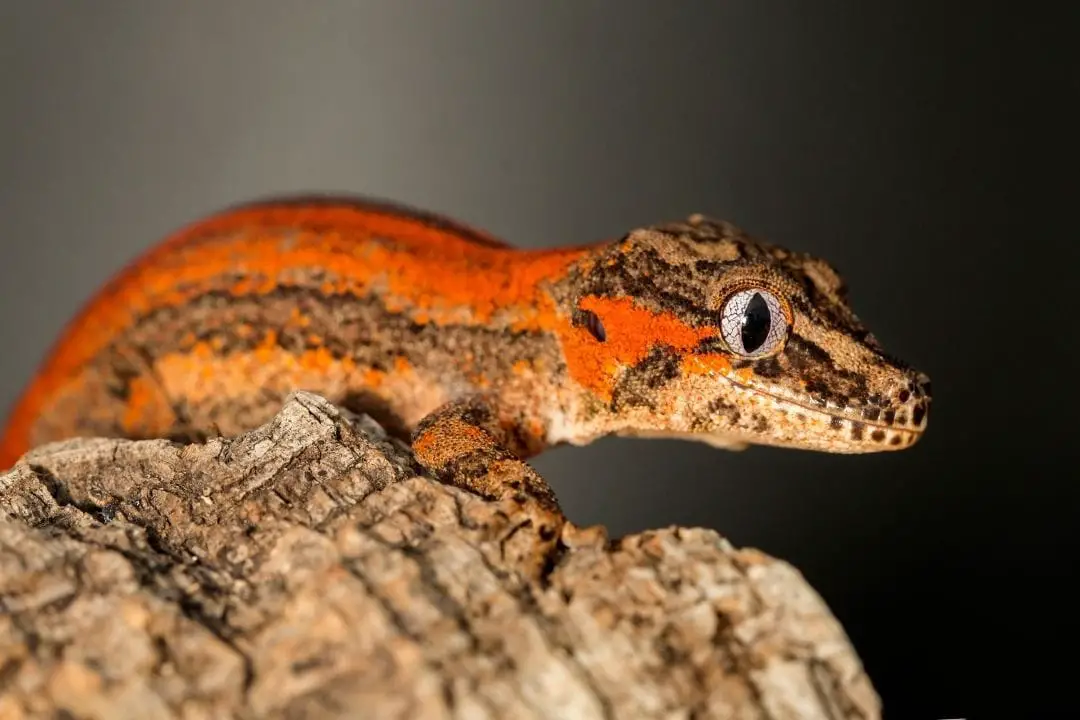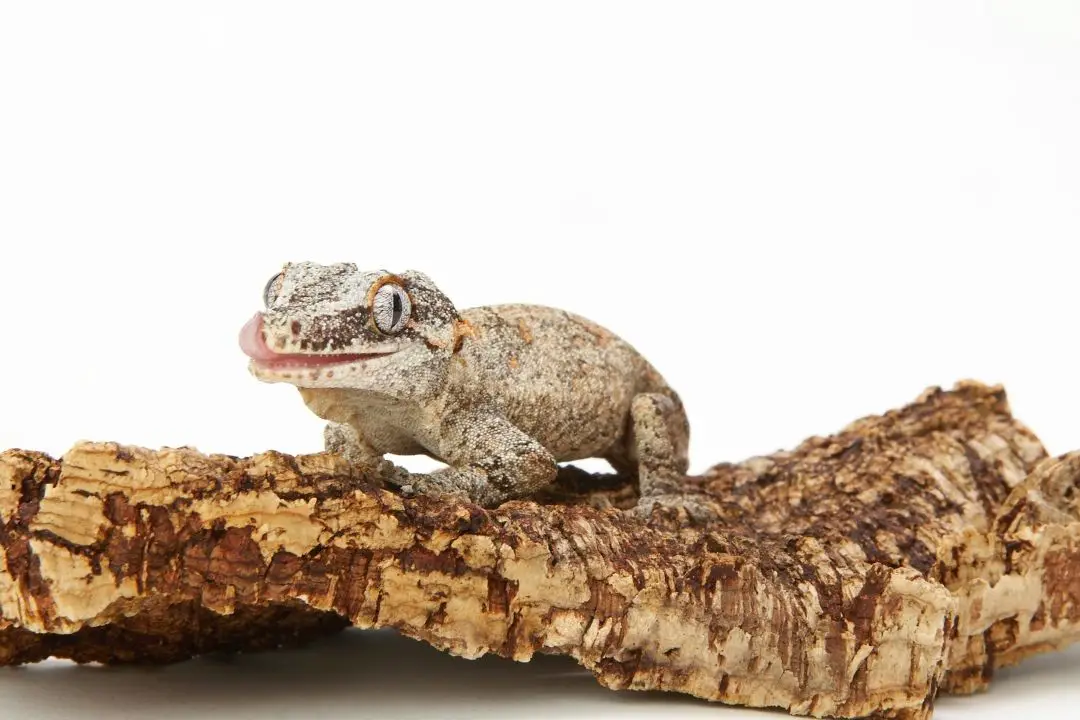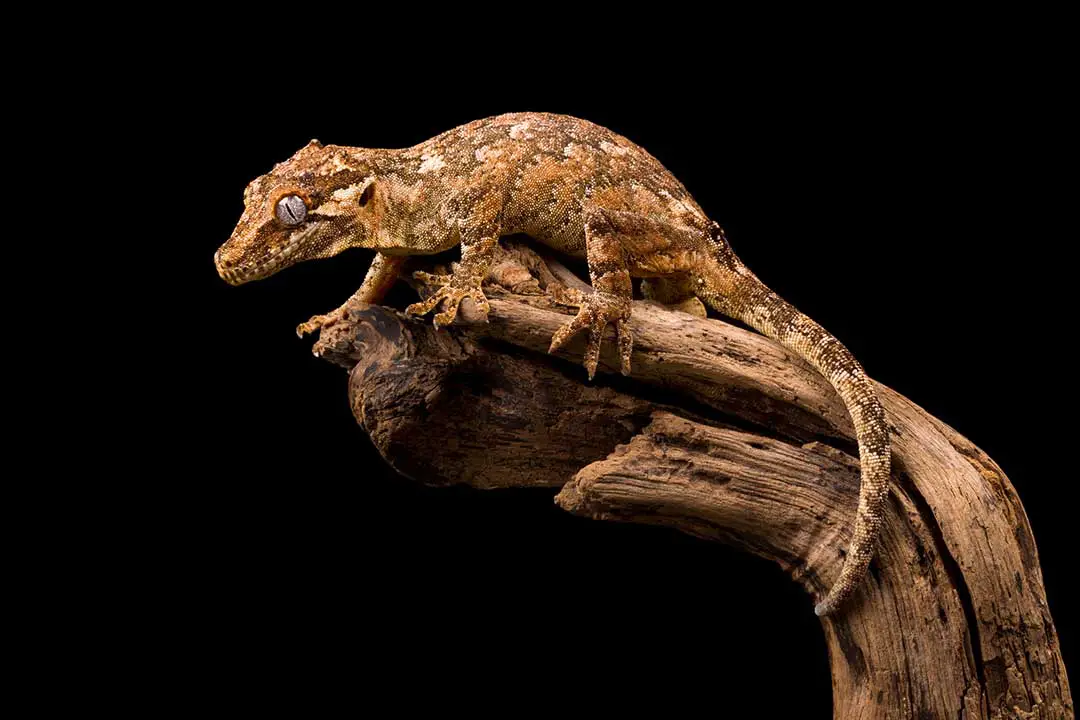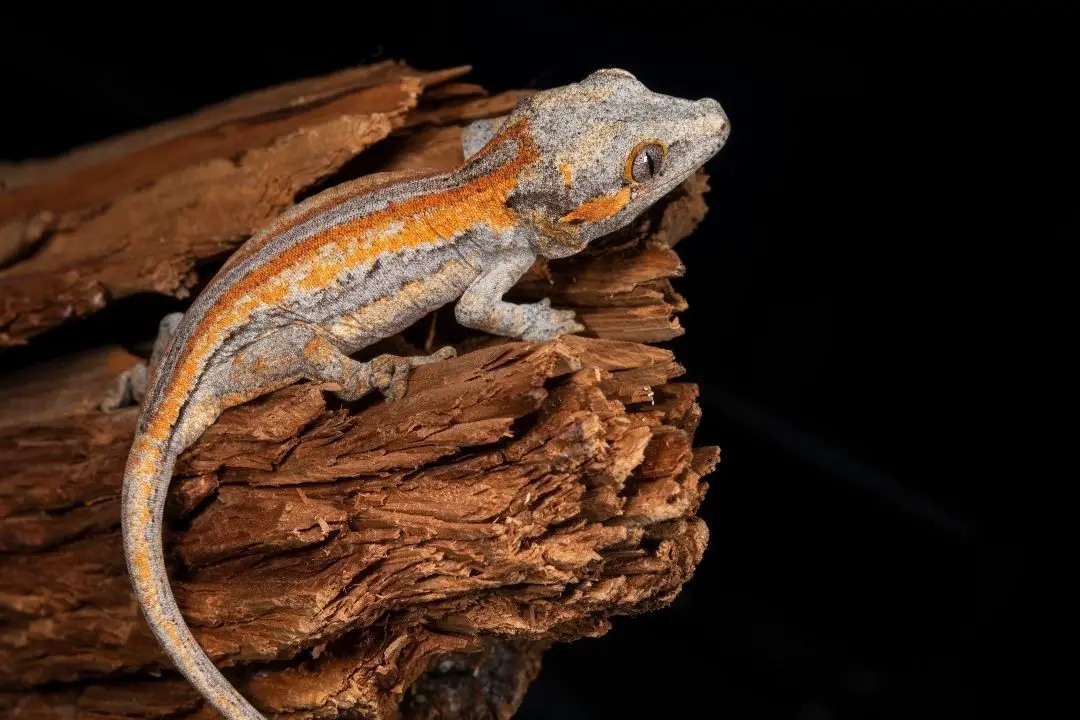Gargoyle geckos (Rhacodactylus auriculatus) are wonderful beginner lizards.
These little guys stay relatively small without being incredibly delicate like chameleons. This makes them easier to handle for a beginner.
These geckos are native to the southern part of New Caledonia.
They have a wide wild diet that includes insects and vertebrate prey such as lizards. They have also been recorded eating sap.
These animals tend to live on shrubs and saplings with relatively narrow diameters so they can easily hold onto their perches.
This guide will help teach you how to keep your gargoyle gecko happy and healthy. We will also go over important factors like breeding and the ideal diet for the species.
Housing Setup
Any reptile enclosure aims to create a little slice of their habitat. You need to provide a thermal gradient to allow your gecko to regulate its temperature.
It also needs plenty of room to exercise, places to hide, and food and water kept off the enclosure floor.
We will review everything you need to know to make the best home for your new pet.
Enclosure for a Gargoyle Gecko
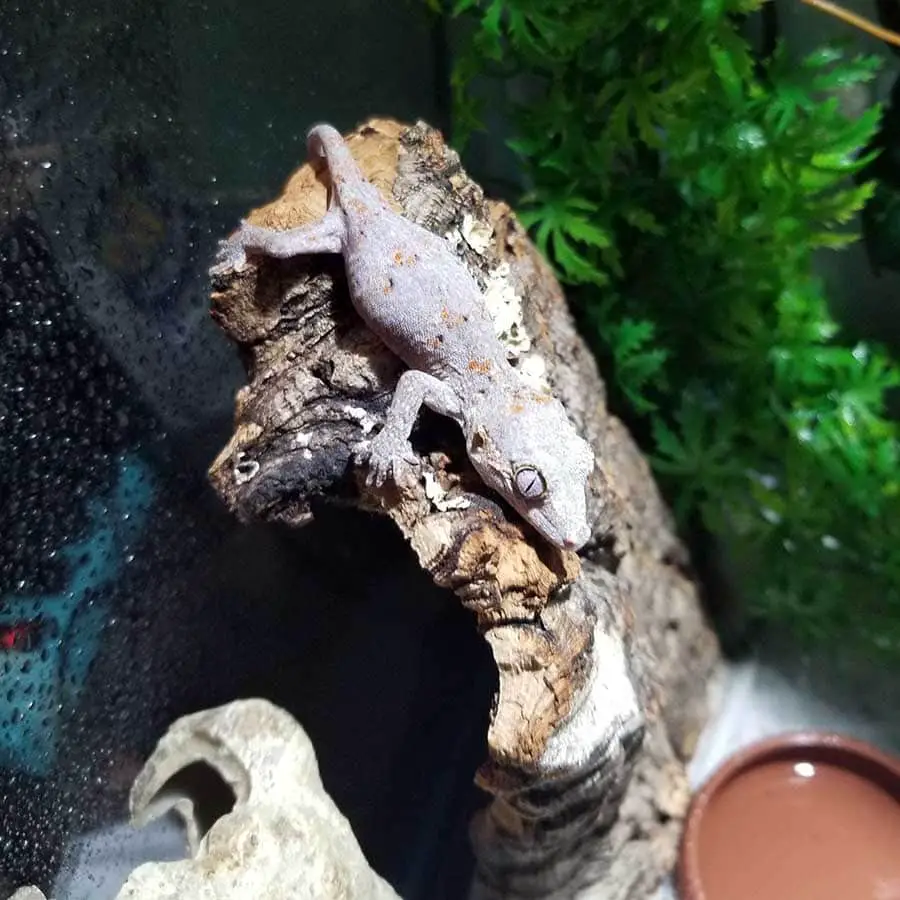
We recommend a PVC or glass enclosure that opens from the front for a gargoyle gecko.
Young geckos need more cover than adults, but they also need to be able to find their food and water.
Unlike crested geckos, a baby in an adult enclosure may become stressed out.
Tank Size for Baby & Juvenile Gargoyle Geckos
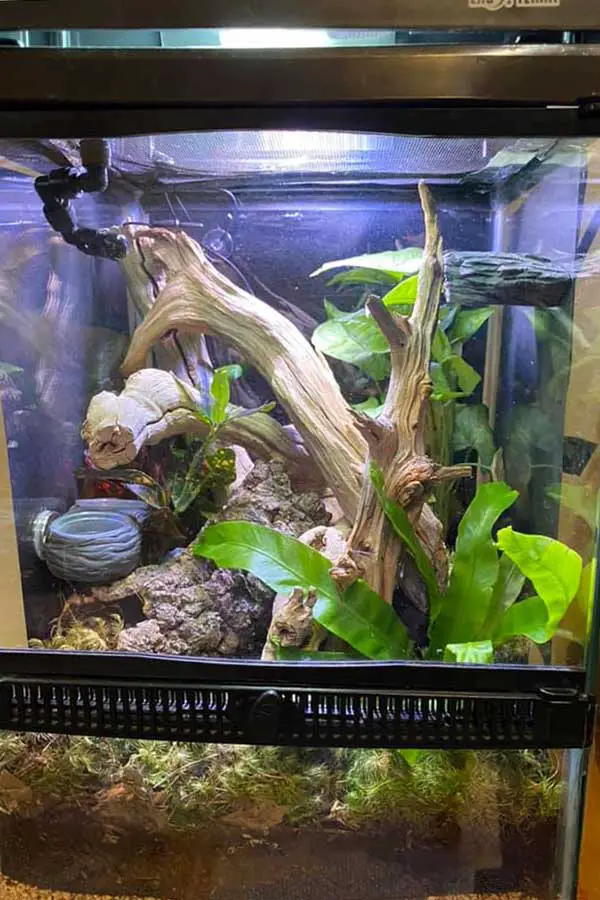
The minimum size for a baby gargoyle gecko is 5-10 gallons. This can hold the gecko until it is ready to move into its adult enclosure.
It can be hard to find a front-opening option in this size. This is best for baby gargoyle geckos and animals that weigh less than 13 grams.
Once your gecko reaches this size, it is time to upgrade to an adult-size enclosure.
Juveniles and babies must be housed alone since they will eat each other at this age. Only group sexually mature adults.
Tank Size for Adult Gargoyle Geckos
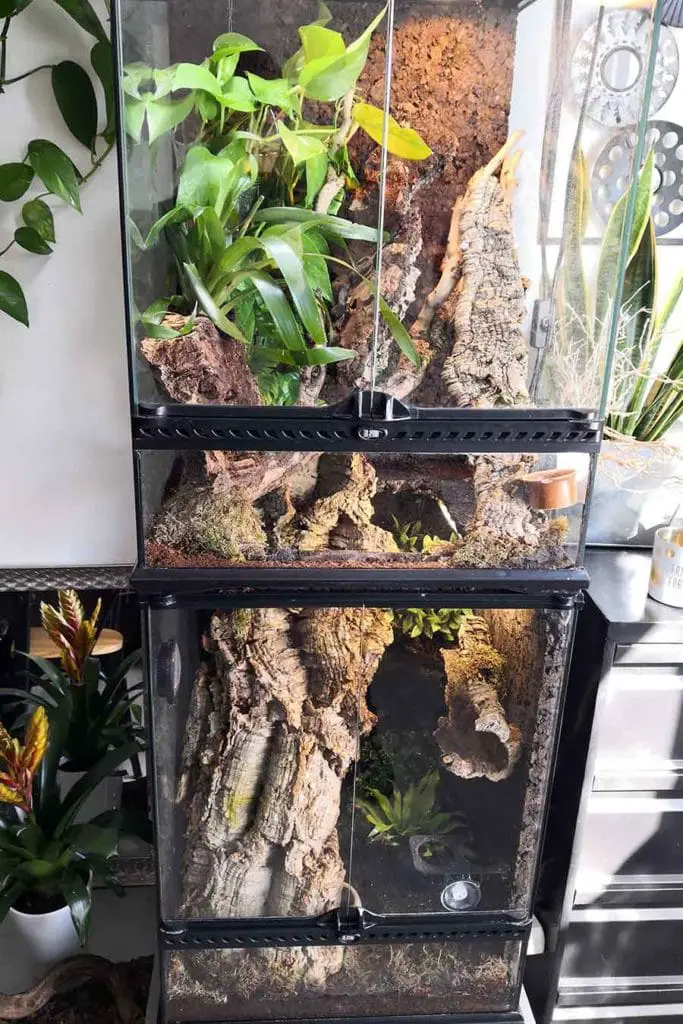
An adult gargoyle gecko needs a minimum enclosure size of 18″x18″x24″.
We do recommend going larger if you have the space. More room means your pet has more space to exercise.
The standard for a single adult is 20 gallons minimum.
To house your geckos together, you need at least 5 more gallons for every additional animal.
You should only house adults of a similar size. You can house all females or a female and a male, avoid having male gargoyle geckos together.
Never house two males or animals that are not the same size when housing more than one gecko. Gargoyle geckos will eat a smaller gecko.
Substrate
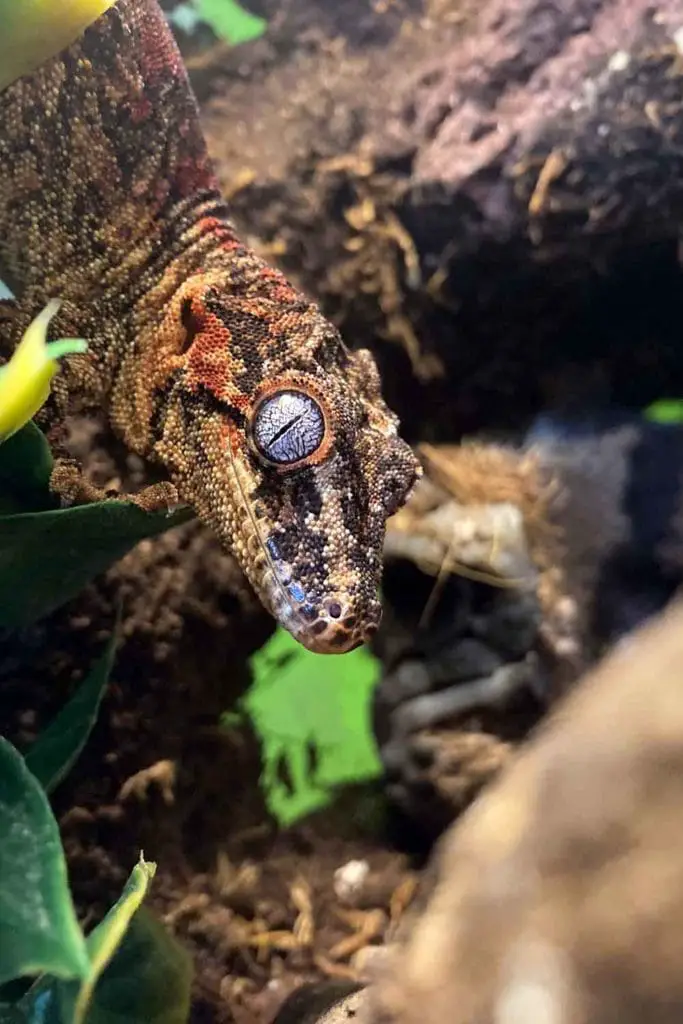
If you do not want a bioactive setup, we highly recommend a natural substrate with a small particle size to help prevent impaction.
The best substrate for gargoyle geckos is ReptiSoil since it helps keep humidity. You can mix up 60% organic topsoil and 40% peat moss to create a DIY substrate option.
You can use paper towels, but they make keeping up the humidity hard, and you will need to replace them entirely once a week at a minimum.
- Never use coconut fiber since it can expand in the stomach. Reptile carpet is also very bad since it can damage your gecko’s toes.
- Never use a substrate with a large particle size to help prevent impaction.
- Pine and cedar beddings are toxic to reptiles and should never be used.
Always use organic substrates if you are DIYing your substrate.
This helps make sure there are no fertilizers or similar substances that can harm your gargoyle gecko.
Heating & Temperature
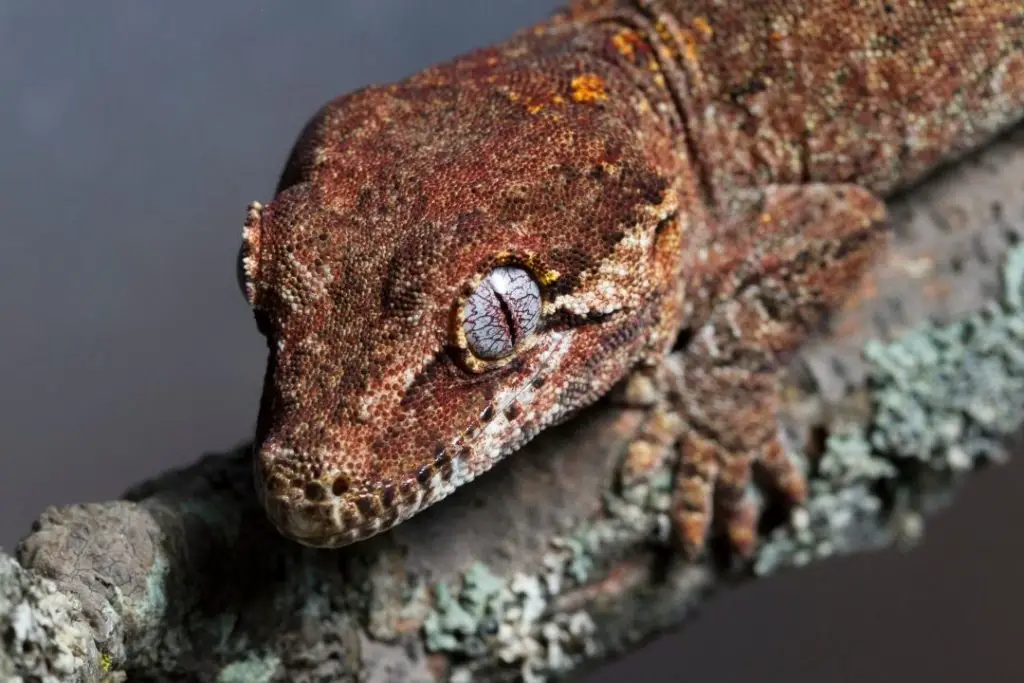
There are two standards here for your gecko, depending on age.
Juveniles and baby gargoyle geckos do best with a small heat mat stuck to the side of the enclosure until they reach 13 grams.
Use a thermostat between the mat and the glass to ensure your gecko does not get too hot. Do not allow this to get over 85 degrees.
Adults do best with a basking light or low-wattage incandescent bulb like this. Ceramic heat emitters are usually too strong for these small enclosures, but they can also be an option.
Always ensure that your gecko cannot touch the heating source directly.
At what temperature should you maintain a gargoyle gecko enclosure?
The temperatures in the basking spot should be no greater than 84 degrees Fahrenheit.
The shady areas in the warm area should be around 77-84 degrees when you check with your heat gun.
The cool area must be 72-74 degrees during the day so your gecko can thermoregulate.
Turn off the lights at night to get the temperatures to be around 68-77 degrees to reproduce something close to their natural habitat.
You should also have a thermometer to monitor both sides of the enclosure.
We recommend a digital model that can handle humidity.
Light
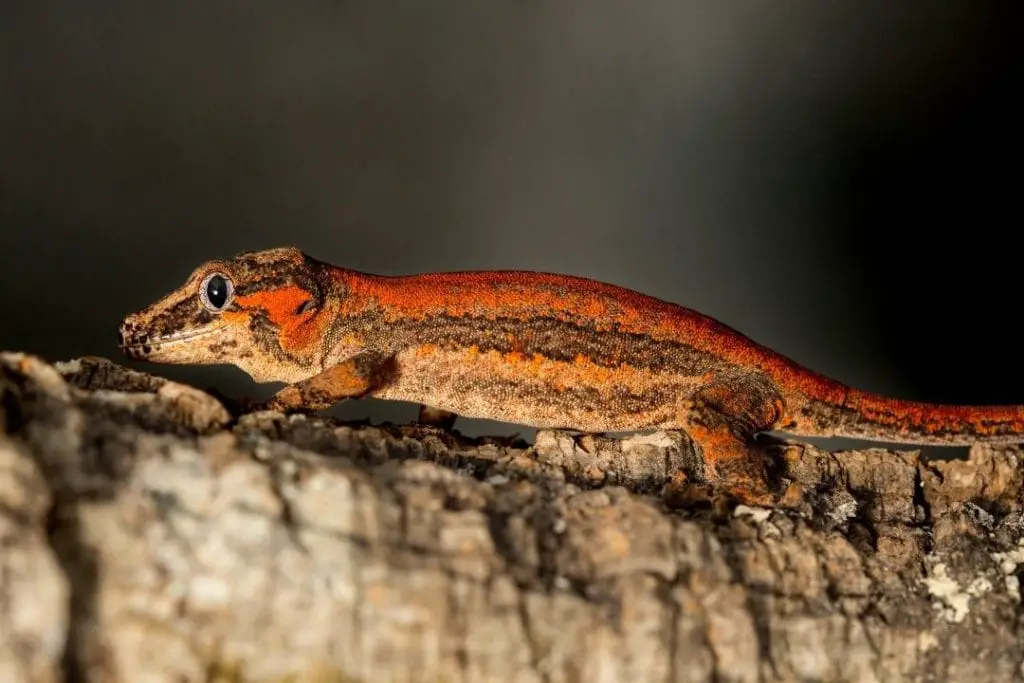
Do Gargoyle Geckos need UVB?
While gargoyle geckos are nocturnal, they still need UVB lighting to help prevent metabolic bone disease and other problems. You do not need a very strong bulb for this.
You only need a 5% UVB bulb set in a dual light hood to accommodate your heating bulb. You will need to use a timer to automate the lighting.
You should aim for around 12 hours on and 12 off. We highly recommend giving UVB even if many care guides say they don’t need it.
While many good diets and supplements will offer D3, it is still best to offer UVB.
This species is nocturnal and should never have any lighting at night.
They do not need or appreciate it. You will want to use a solar meter to check the UVB light levels. You will want a 1.0-2.0 reading at the basking branch.
Otherwise, it would help if you positioned the bulb at least 4-6″ away.
Babies need the lighting attached to a stand and placed further away.
Make sure your UV bulbs do not have glass or plastic over the bulb since this will block the UV rays from reaching your gecko.
Shelter and Enclosure Design
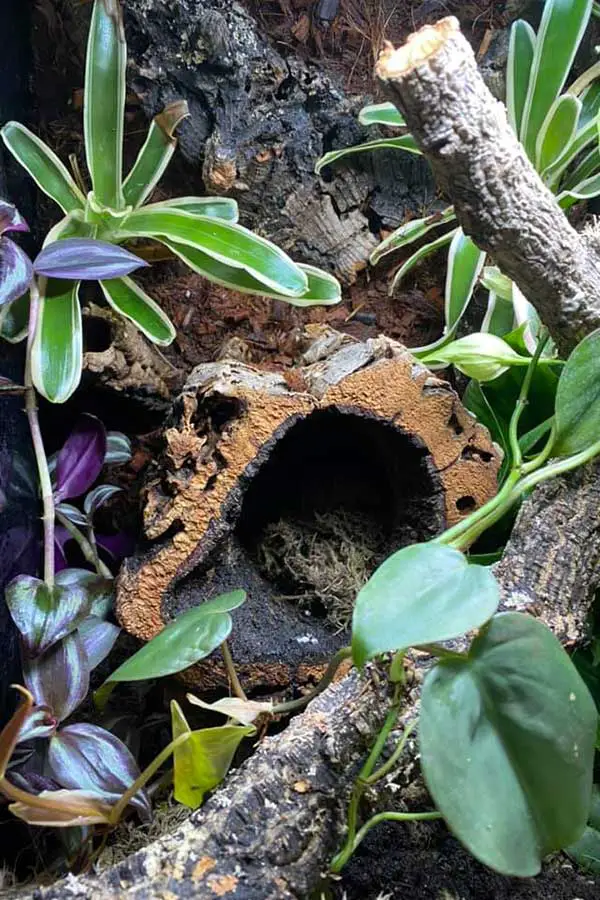
Gargoyle geckos have three needs you need to consider when you are decorating.
They need places to hide, are semi-arboreal, and need climbing and jumping opportunities, and gargoyle geckos thrive with areas that will collect water to help keep them hydrated.
Use artificial plants (or live plants for bioactive), vines, cork rounds, and branches to create spaces for your pet.
If you use artificial greenery, make sure it is rated for outdoor use or is designed for reptiles so it can stand up to the conditions in the enclosure.
You do not need specific hides, but do create shady areas for your pet to use with greenery.
You can plant the enclosure, but you will need to use grow bulbs for the plants and ensure they are not toxic.
We do not advise using minimalism for this species since they spend most of their lives on plants in the wild. They only visit the ground to change plants or hide among roots in their native habitat.
Water
Gargoyle geckos will get most of their water from misting, but you should still offer a small cup of water near where you feed them.
There are biodegradable cups that are meant for feeding geckos.
These are great for both food and water. This helps keep your gecko hydrated in between misting.
Gargoyle Gecko Humidity Requirements
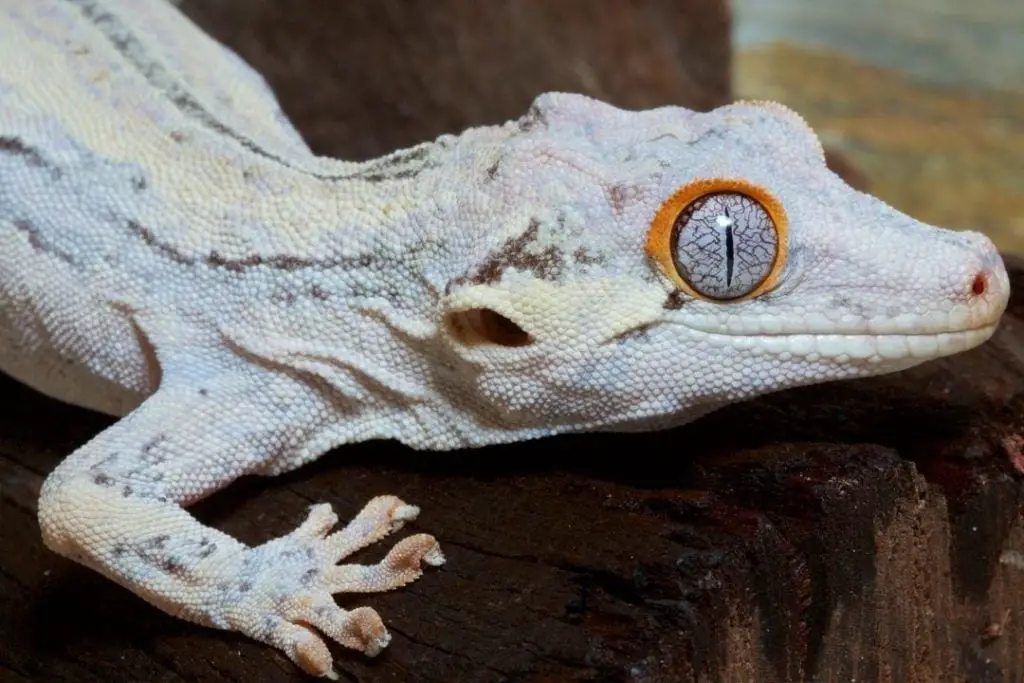
Gargoyle geckos prefer humidity levels around 50-70%. It would help if you misted once you see a reading at around 50% and let the enclosure dry to help prevent mold growth.
Do gargoyle geckos need to be misted?
Most gargoyle geckos prefer drinking water from the misting.
Use only tap water since your gecko needs the trace minerals present in tap water.
If it is safe for you to drink, it is safe for your gecko.
It would help if you misted at least once daily; you can also use a cool air humidifier.
But this may change depending on your local climate and home, so you should always check your humidity with inexpensive hygrometers.
If you see hard water stains, they can be cleaned up easily with lemon juice on a cotton ball.
Enclosure Maintenance
If you have owned any reptile, the maintenance will always be pretty similar unless you opt for a bioactive enclosure.
A standard setup requires regular checks for poop and daily water changes.
Make sure you replace any soiled substrate with fresh, or you may find very little substrate by the time your full cleaning day comes around.
It would help if you did a deep clean once a month. This requires you to put your gecko into a temporary enclosure and clean absolutely everything.
This means removing all the furnishings and setting them aside to be cleaned or replaced. Ensure you turn off the heating and lighting and let any glass surfaces cool before cleaning them.
Spraying cold liquid on the hot glass will crack it from thermal shock. Remove all the substrate and clean all the surfaces in your enclosure.
Make sure you use a reptile-safe sanitizer and leave the enclosure open to air out while you clean the water dish and other furnishings.
You can sanitize many things like branches, but be careful and throw away anything that is getting rough or too dirty.
If you have a backdrop in the enclosure that your gecko can access, make sure to give these a good clean and clean your feeding dish.
Once everything is clean, use fresh substrate and replace all the decorations before adding your gecko to the enclosure.
Feeding
Gargoyle geckos in the wild primarily eat insects and other reptiles, but they also eat things like fruit or tree sap, depending on the time of year.
Captive gargoyle geckos do great on a premade crested gecko diet and live insects. We will teach you what to feed your pet.
Gargoyle Gecko Diet
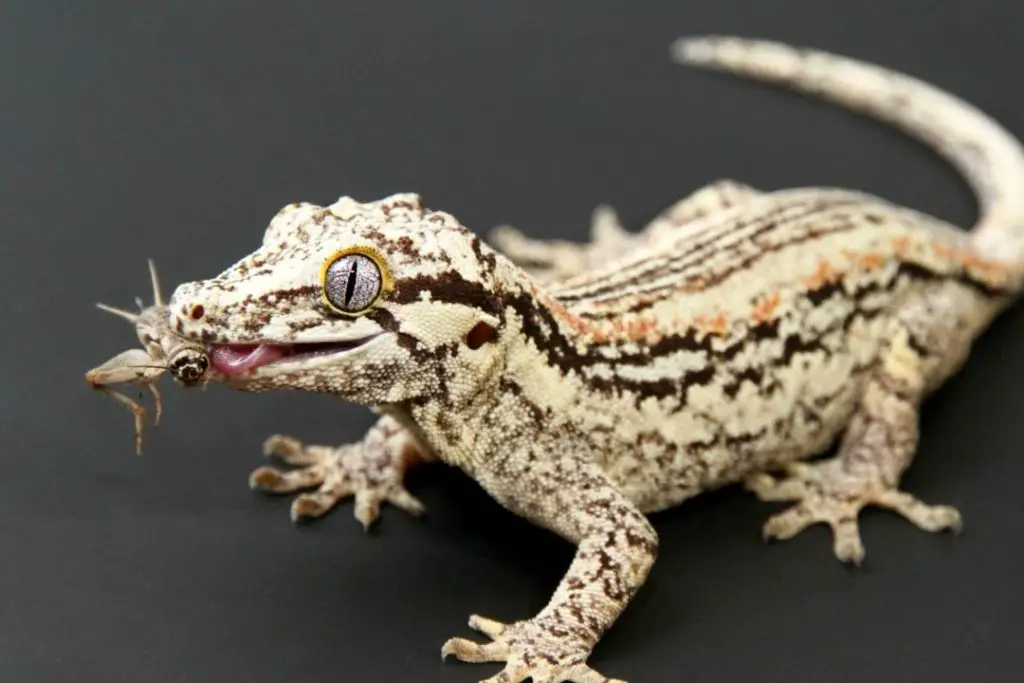
Most captive gargoyle geckos do great with a crested gecko diet powder augmented with insects to help meet their higher protein requirements.
We will recommend a few brands here, but your gecko may prefer a specific brand and flavor.
Ask your breeder what they feed their geckos and offer the same flavor. If they only feed insects or feed a lower quality food, try to find a flavor your pet likes.
It may take some trial and error to find what your pet enjoys.
Please do not feed diets other than these. Some diets are notably very poor in quality.
Gargoyle geckos fed these diets are at risk of problems like a metabolic bone disease.
We can recommend the diets Repashy, Leapin’ Leachie, Zoo Med, Pangea, Lugardi, and Arcadia StickyFootGold.
This needs to be mixed to the consistency of ketchup or a smoothie and offered in a biodegradable gecko feeding cup.
Gargoyle geckos love messing with their food and can end up with messy toes.
Be sure to regularly check the toes for stuck-on food and clean their feet, or they can have stuck sheds and other problems.
Gargoyle geckos also need feeder insects regularly to stay healthy and meet their higher protein needs.
Dubia roaches, discoid roaches, silkworms, crickets, and black soldier fly larvae are all excellent food sources.
Only feed captive-bred feeders that have been gut loaded for at least 2 days before a meal.
Your insects must also be dusted before they are offered a calcium powder.
The size should be smaller than the distance between your gecko’s eyes.
Supplements and Treats
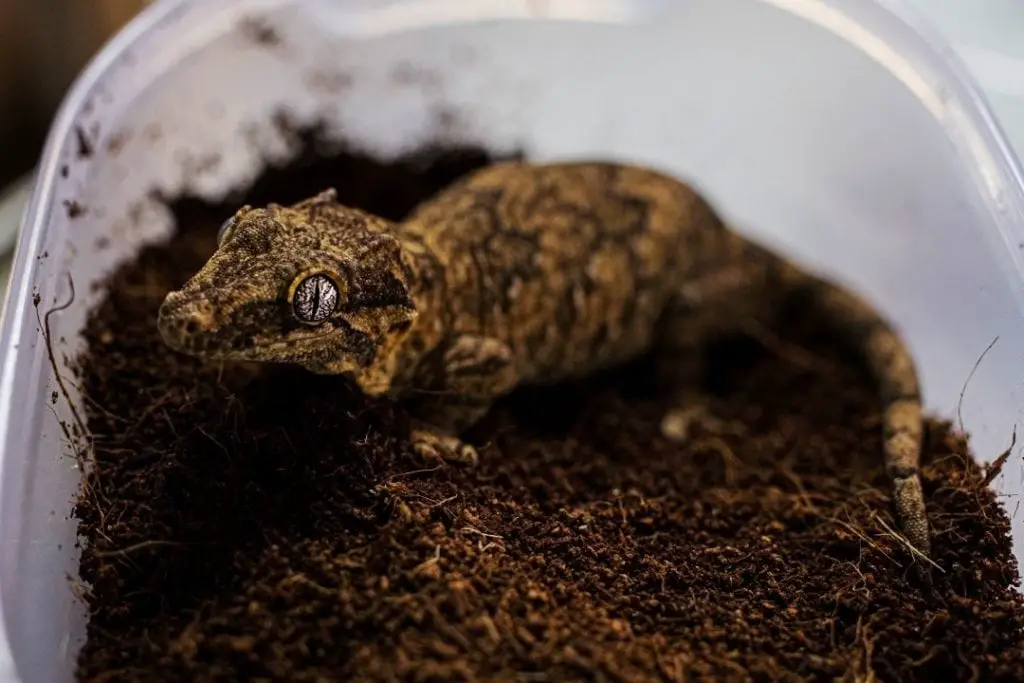
All feeders must be dusted with calcium powder and gut-loaded before a meal.
Use a calcium powder without vitamin D if you use UVB lights.
Vitamin D3 is only needed if you do not provide UVB lighting. You can offer waxworms, pinky mice, or anoles as a treat if you like.
You can also offer some fruit, but this should be rare since your gecko will start refusing its regular diet if you spoil it.
Do not offer treats more than once a week; avoid them if your gecko is becoming obese.
How often should you feed a Gargoyle gecko?
Juvenile gargoyle geckos need their crested gecko diet daily, with feeder insects offered every other day.
An adult gargoyle gecko needs the diet every other day and insects twice a week.
You can skip a feeding every two months or so to help encourage the gecko to burn fat. Only skip meals for adults.
Watch the gecko and offer less fatty feeders if you notice your gecko is becoming obese.
Unsafe Prey
Some feeder insects and prepared diets are not suitable for gargoyle geckos.
Never feed these to avoid serious health problems and a visit to your reptile vet.
Most other brands do not have the right nutrient ratios to be fed regularly, including some seen in reptile stores.
Never feed any feeders that aren’t on the safe food list since they can cause health issues.
You should also never feed wild hornworms since they are very toxic.
Shedding
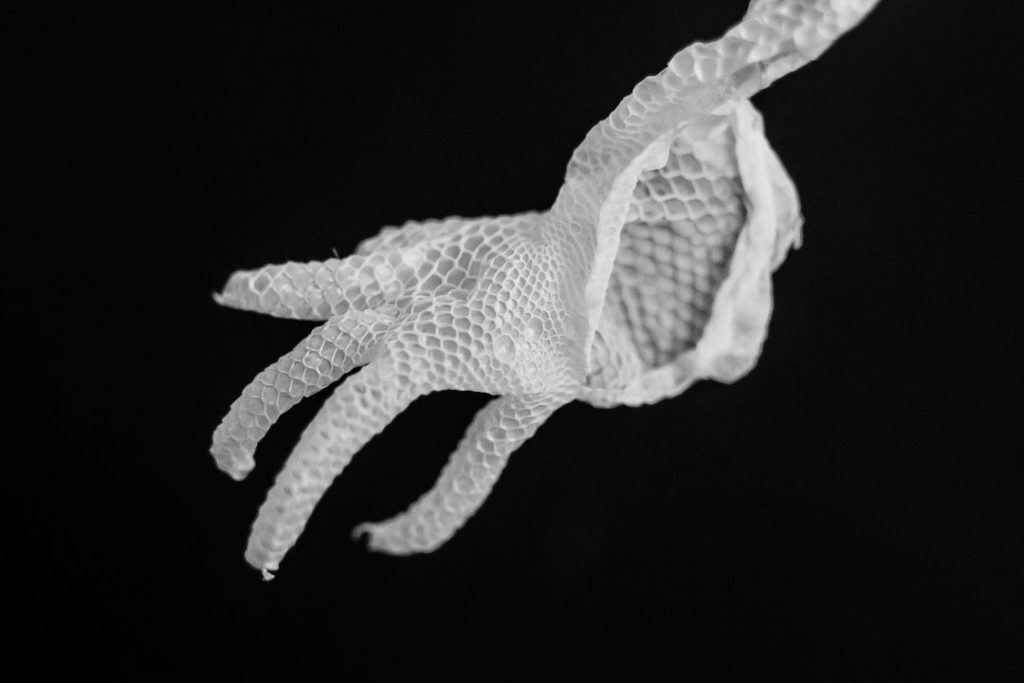
Gargoyle geckos need to shed to grow larger. They also shed their skin to heal. If you keep up on misting, your gecko should shed well each time.
Always check areas like the toes for stuck sheds and use a wet cotton swab to help budge it.
Although they can readily regenerate tails, be careful not to pull on a skin shed that does not easily come off.
Shedding problems are related to humidity; check your temperature and humidity and increase it a bit with some misting to help your gecko shed.
You can have your gecko soak in warm water or a damp paper towel to help stubborn areas.
Hibernation
Do Gargoyle Geckos Hibernate?
Gargoyle geckos do not hibernate, but some animals do well with lower temperatures in the winter if you are breeding them.
If you house a breeding pair together, the male and female should be separated in the winter to allow the female to rest and recuperate after laying eggs.
Breeding Gargoyle Geckos
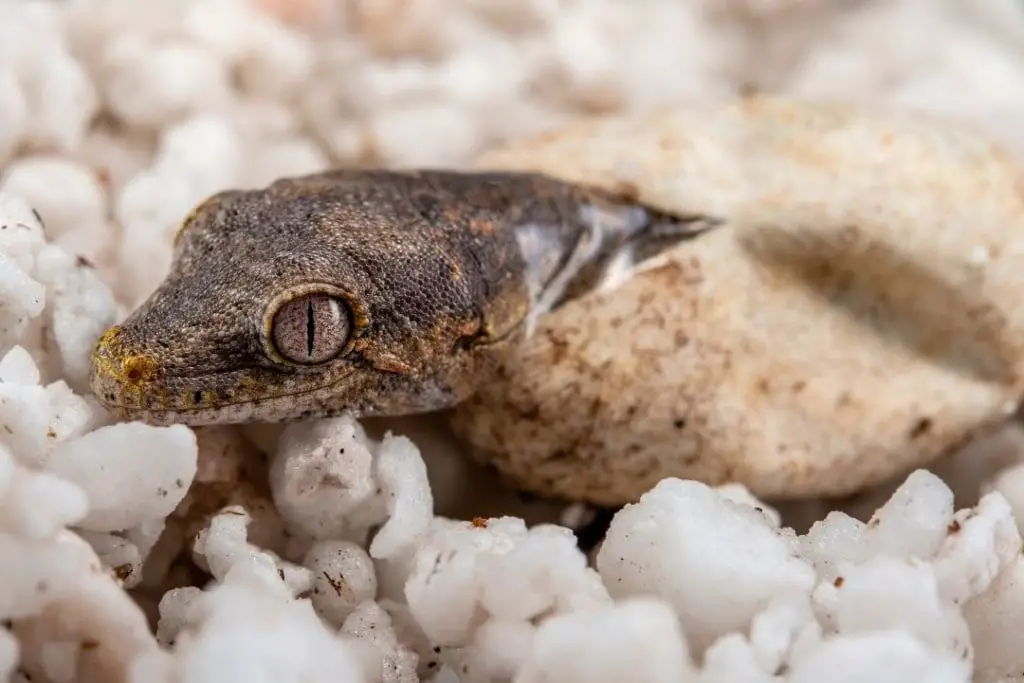
Gargoyle geckos are very easy to breed. If you house a breeding pair, they will breed on their own.
You will likely not see any copulation, but they will mate so long as both animals are adults.
If you house them separately, introduce the male to the enclosure and watch to ensure the animals are not aggressive.
- Only breed animals that are a similar size since gargoyle geckos are cannibals.
- The enclosure needs to have a fragile substrate and a laying box filled with peat moss and sand to ensure the female lays there and you can find the eggs. Adults will eat both eggs and hatchlings.
- Make sure your female is fully grown and mature before introducing the male.
- The male should also be a similar size, or he will be bitten or even eaten by the female. If you house the animals together or introduce them, check their tails daily for bites. This means the animals aren’t getting along and should only be kept together long enough to breed.
- They should handle breeding easily unless the animals hate each other. You can also have breeding trios of one male and two females. Keep a very close eye since females can fight each other. Each female will lay one or two eggs per clutch.
- Once eggs are laid, remove them promptly to a box filled with an incubation medium. There are a few great options, but many breeders use options like Pangea Hatch since you can see when it gets dry. They incubate at around 73-82 degrees, so they are easy to hatch.
- Once the babies hatch, place them in separate enclosures since they will eat each other. Ensure you find a home for the babies since females can have multiple clutches in a year.
How to Handle Gargoyle Geckos
Gargoyle geckos are easy to handle since they are slower and less jumpy than crested geckos. Baby gargoyle geckos tend to be skittish when young but will calm down with regular exposure to you.
Handle gently at least once a week and try keeping the enclosure near somewhere you spend quiet time like a desk.
Make sure you handle your gecko regularly once a week once they are tamed or they may become frightened of you.
Gargoyle geckos are not domesticated and will return to wild behaviors without regular human contact.
Be gentle when you pick them up since they are small, and gargoyle gecko handling without proper care can get them injured.
Always scoop your gecko up gently and never squeeze them.
Never grab them by the tail since they will drop it. It will grow back, but this is still something you should avoid.
FAQ
This section goes over a few common questions you may have about the rhacodactylus auriculatus.
Please ask in the comment section below if you do not see your question here.
What Do Gargoyle Geckos Eat?
Gargoyle geckos in captivity eat insects and a prepared crested gecko diet. This makes feeding them very easy, even for beginners.
All you need to do to feed your gecko is mix the gecko diet powder to the consistency of ketchup or a smoothie and offer it to your pet as gargoyle gecko food.
Feed live insects as well, available in all reptile stores or online.
Are Gargoyle Geckos Nocturnal?
Gargoyle geckos are typically called nocturnal, but they are crepuscular. This means they become active at dusk and typically stay active during the night.
You may not see much movement from your pet during the day, but once the lights go down, you can expect to see activity. We recommend feeding your gecko in the evening to mimic when they typically eat in the wild.
Can You Feed a Gargoyle Gecko Mealworms?
Gargoyle geckos can eat mealworms, but these worms have hard chitin that can cause digestive problems. They should be offered very rarely.
Waxworms are better for treats, and silkworms are a significant part of their regular diet.
Are Gargoyle Geckos Friendly?
Adults Gargoyle geckos are typically docile and friendly with regular handling; young geckos can be skittish when first acquired.
It would help if you gave newly purchased gargoyle geckos some time to relax and get acquainted with their enclosure before attempting to handle them.
Female gargoyle geckos and male gargoyle geckos are not different behavior-wise.
Why are Gargoyle Geckos so Expensive?
Gargoyle geckos are expensive partly due to a lack of breeders and a high demand.
At the time of writing, there are not enough to go around, so the prices are higher compared to other gecko species, some gargoyle gecko morphs being more expensive than others.
Gargoyle geckos also lay only one or two eggs per breeding.
This takes a bit longer to produce than other common pet lizards and drives the gargoyle gecko cost up.
If more breeders start up, the prices should go down over time as they are getting more popular in the pet trade.
You can find a reputable breeder on morphmarket, at a reptile show or in several facebook groups for gargoyle geckos.
Sources
Bartlett, P.P., Griswold DVM, B. and Bartlett, R.D. 2001. Reptiles, Amphibians, and Invertebrates, an identification and care guide. Barron’s Educational Series, Hauppauge, NY. 279pp.
DeVosjoli, Phillippe, Repashy, Allen, and Fast, Frank. 2013. Gargoyle Geckos Advanced Visions, Inc. Vista, CA.pp145-239.
Henkel, Friedrich-Wilhelm and Schmidt, Wolfgang. 1995. Geckos, Biology, Husbandry, and Reproduction. Kreiger Publishing Company, Malabar, Florida. 237pp.
Seipp, R. & Henkel, F. (2000). Rhacodactylus, Biology, Natural History & Husbandry. Chimaira Buchhandelsgesellschaft mbH. Frankfurt am Main. 173pp.
DeVosjoli, Phillippe, Fast, Frank, and Repashy, Allen. 2003. Rhacodactylus: The complete guide to their selection and care. Advanced Visions, Inc. Vista, CA. 145-239.
World Weather and Climate Information. “Climate and Average Monthly Weather in Noumea, New Caledonia.” Accessed June 28, 2019. https://weather-and-climate.com/average-monthly-Rainfall-Temperature-Sunshine-fahrenheit,Noumea,New-Caledonia
The Red List – Knob-headed Giant Gecko
Conclusion
We hope this guide helps you keep your new lizard pets healthy and happy over the 15 to 20 years these little guys live.
The rhacodactylus auriculatus with its fantastic colors, cranial bumps, and triangular-shaped head makes great and exciting pets as long as you take the time to care for them properly.
If you have any questions or comments, please leave them below.
